 CHILDREN OF
THE EMPEROR
The Emperor`s Children Space Marine Legion
For countless centuries, stretching back to the ancient times of the Horus Heresy, the corrupted Space Marines of the Emperor's Children Legion have been the bane of the Imperial Inquisition, spreading their foul and decadent ways across the galaxy like a plague of immorality. Loyal Inquisitors train for decades to steel themselves against the temptations of Slaanesh in order to combat this seductive, deadly threat to Imperial order. Yet, long ago, these agents of Chaos were counted among the servants of Mankind; indeed, they once were the most devoted warriors of the Emperor. 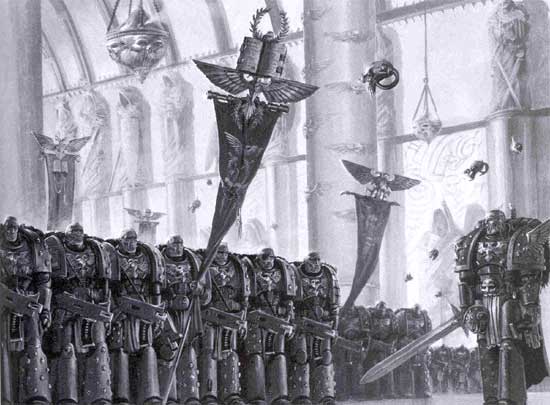
Long ago, during the Age of Strife, warp travel became impossible and all the worlds which humanity had claimed were cut off from one another, forced to fend for themselves without the support of their neighbours in other star systems. The Libram ex Dominar, one of the few surviving texts from this time, tells that Chemos was one such world, a mining colony dependent on interstellar trade for food. The planet's rulers made every effort to extract enough raw food from the harsh environment to feed their people, but Chemos was a world dying a slow death. This all changed when one day the guards on the walls of Callax, the largest remaining factory-fortress, saw a meteor descend from the clouds, trailing fire across the sky before impacting barely a mile from the fortress walls. Though little manpower could be spared, the ruling Executive of Callax sent a handful of scouts to investigate the impact site, hoping for some evidence of human survivors on other worlds. What they found became legend.
Fulgrim grew unnaturally fast, becoming a strong, capable man. At half the age of his fellow workers he was able to fulfil his obligations to the Executive, working for days without rest. Not only was he physically proficient, he quickly grew to understand the technology of the machines he worked with, and began to contemplate their improvement. By the fifteenth anniversary of his fall from the sky, Fulgrim had risen from the ranks of the workers, first becoming an engineer then one of the Executive itself. Learning of the slow deterioration in Callax and the other settlements of Chemos, Fulgrim set himself the task of saving his world. One by one he convinced his fellow members of the Executive to fight against the entropy that was destroying Chemos. Under Fulgrim's leadership, teams of engineers travelled far from the factory-fortresses, reclaiming long-dead outposts in the planet's most inaccessible regions. The ancient mines were reopened and expanded, bringing more and more minerals into Callax and allowing the construction of more sophisticated machines. Recycling efficiency grew until, at last, Callax was producing more that it consumed. Seeing his people prosper, Fulgrim took pride in fostering he re-emergence of art and culture, reclaiming the spirit of humanity that had been sacrificed so long ago in the struggle or survival. As Callax grew, the other settlements began to ally themselves with Fulgrim. Fifty years after Fulgrim fell from the sky he rose to sole rulership of Chemos. It was not long after this that the planet's isolation came to an end. From the grey sky came a flight of dropships, armoured and battle-scarred, each bearing the same symbol, a two-headed eagle. On hearing of this, some fragment of memory stirred in Fulgrim. Chemos had no formal army, but the dropships' landing zone had been surrounded by the Caretakers, the police-soldiers responsible for maintaining order in the factory-fortresses. Fulgrim sent word to the Caretakers to stand down and allow the visitors from above into Callax.
From the Emperor himself, Fulgrim learned of Terra, of the Great Crusade to reclaim the galaxy, and of his own origins. Though the story was fantastic he knew it to be true, and at the Emperor's request Fulgrim travelled to Terra to join his Legion, the Emperor's Children. Unlike the other Legions fighting in the Crusade, the Emperor's Children were few in number - an accident had destroyed nearly all of the precious gene-seed and, with the Primarch himself lost, the rebuilding had been a slow process. Fulgrim addressed the two hundred warriors who were then all that the Legion could muster. To them he gave the sacred task of bringing the Emperor's wisdom to all the stars in the sky. "We are His children," the Book of Primarchs relates he told them, "Let all who look upon us know this. Only by imperfection can we fail him. We will not fail!" So inspired was the Emperor by the words of his newly-found son that he bestowed on Fulgrim's Legion a unique honour: the Emperor's Children would be permitted to display the Imperial Eagle on their armour's chestplates, the only Legion then allowed to display the symbol in such a manner. Fulgrim was anxious to begin his conquest of the unknown regions of the galaxy, but realised that his two hundred warriors were far too few to undertake a crusade on their own. With the Emperor's blessing he and his Legion joined the Luna Wolves, and Fulgrim fought side-by-side with his brother Horus, aiding him in his newly-assigned task of pacifying the Eastern Fringe of the galaxy. The Warmaster himself praised Fulgrim and his Legion, declaring them the living embodiment of the Adeptus Astartes.
During its isolation, the archivists of Chemos recorded a picture of a bleak, unforgiving world. Warmed by two small, distant suns and surrounded by a nebular dust cloud, it experienced neither day nor night, only a perpetual grey twilight in which the stars never shone. Settled long ago as a mining colony, the cities of Chemos had fallen into decay since their isolation from Terra. Without resources from other worlds thousands starved, and eventually it fell to a few hardy fortress-factories to keep humanity alive on Chemos. Short of food, water and energy, the people of Chemos were forced to limit themselves to the meagre supplies available-all citizens worked every waking hour, operating the vapour mines that drew moisture from the thin air, and the huge synthesisers that endlessly recycled food, turning yesterday's waste into today's sustenance. Recreation, art and leisure were sacrificed in order to ensure survival, and efficiency became the only value adhered to.
After coming under the rule of Fulgrim and its rediscovery by Imperial forces, Chemos quickly expanded its industrial base tо become an important source of processed minerals. The fortress-monastery of the Emperor's Children was established in the centre of Callax, drawing recruits from the strongest, bravest and most intelligent of the planet's population. Though Fulgrim himself never returned to Chemos, he took great care to see that his will, as the emissary of the Emperor, was followed. The recruits from Chemos proved themselves strong and resourceful fighters, but even so only a handful of them passed the rigorous tests imposed by Fulgrim to satisfy himself that they were worthy of becoming one of the Emperor's Children. After the lifting of the Siege of Terra, and the end of the Horus Heresy, Imperial forces set out to assault Chemos from orbit, intending to destroy the Emperor's Children's fortress-monastery and eradicate any trace of Chaos from the world. Following this action Chemos was quarantined by the Inquisition, and in the past ten millennia no further information, not even a record of Exterminatus, has appeared in Imperial databases regarding the world. Studying ancient battle and status reports, the scribes of the Inquisition have pieced together some of the practices of the Emperor's Children Legion, though the original doctrine texts were lost with the Legion itself. The Legion accepted nothing less than perfection in all their endeavours, and worked ceaselessly to perfect their military operations. Each and every Space Marine trained every waking hour for his assigned task, whether it be foot soldier, driver, gunner, scout or sniper. Every aspect of battle was analysed and used to their advantage, from terrain and weather to deployment or reserves. Nothing was left to chance. In combat the Emperor's Children were as brave as any Space Marine who ever lived. Sustained not merely by the example of their peers but by a deep individual belief in their duty, they fought to the best of their abilities in all conditions, whether the battle was a massive attack or a simple patrol. It was widely believed that no Space Marine of the Emperor's Children had ever been routed in battle. Similarly, the Legion was highly demanding of forces allied with it -signs of hesitation or inefficiency in the Imperial Guard or even their brother Space Marines were not tolerated. The principle of leading by example was ingrained into every fibre of the Emperor's Children, and they had little patience for any other regime.
According to the surviving Legion monuments seized by the Inquisition, the Emperor's Children did not literally deify the Emperor, but the strength and passion of their belief in him was equal to that of any adherent to the Imperial Cult. Following Fulgrim's lead, the Legion believed that the Emperor represented the pinnacle of Humanity, and that only by following his example was it possible to attain one's full potential as a Human Being. Any person or group who resisted this goal was below contempt, not worthy even of consideration as a brother Human. However the Legion's near-worship of the Emperor was extremely hierarchical. The Emperor's perfection was thought to be embodied first by the Primarchs, by following their example, then the officers of the Legions, the Captains and Lieutenants, and finally the Sergeants and Space Marines themselves. Thus it is speculated by Inquisition theorists that it was possible for the entire Legion to be corrupted by seducing Fulgrim and his fellow officers. The surviving scrolls tell that, before their fall to Chaos, the Emperor's Children believed that the Emperor would eventually achieve total conquest of the galaxy, and with all hindrances removed there would remain no obstacle to the perfection of Human civilisation. While their studies of battle were all-important, the Space Marines of the Legion were taught reverence for the cultural aspects of civilisation -music, art and sculpture among others. Artisans were brought from all the worlds of the Imperium to fashion the Legion's armour, weapons and vehicles to the highest standards. The diversity of Humanity was highly prized, and there were few restrictions on the avenues of learning available to the Legion. After the near destruction of the Legion in the gene-seeding process, surviving fragments of the Codex Apothecarion Terra indicate that absolute excellence was demanded of the Apothecaries who handled and worked on the precious genetic material. This ethos quickly merged with the Legion's general belief in perfection, so that the Emperor's Children gene-seed was perhaps the most pure and stable of all the Legions. Only the finest physical specimens were chosen for implantation, so that the mutation rate of the gene-seed was practically zero. Every enhancement produced by the gene-seed functioned at peak efficiency, allowing the Space Marines to achieve their full potential in battle. No other Space Marine Legion achieved such a goal, and the technology and expertise required have never been rediscovered in the millennia following the Horus Heresy. "Children of the Emperor! Death to his foes!"
As Fulgrim turned, so too did his Lord Commanders. They knew their Primarch to be the embodiment of perfection, and needed little convincing to follow him into Slaanesh's service. Returning to their Legion, Fulgrim and his Lord Commanders met with their captains, preaching to them the glory of Chaos. The captains in turn passed the worship of Slaanesh to their subordinates, and so on until the entire Legion had forsaken the Emperor. Denouncing the teachings of their former idol, they turned wholeheartedly to Slaanesh, giving the Prince of Chaos the same measure of devotion they had once shown to the Emperor. Slaanesh, in turn, bestowed visions of paradise on the Emperor's Children, a galaxy of ultimate freedom, where no evil was possible because every experience was a source of pleasure. The Legion's Chaplains exhorted their brothers to pursue this dream, to savour every sensation. The perfection of the Emperor's Children became perfect hedonism, limitless in its scope, unstoppable in its fury. When loyal Space Marines arrived on Istvaan V, the Emperor's Children were first among the traitors who stood against them, aiding in the massacre of the loyal Legions with gleeful savagery. Horus's rebellion spread, casting the entire Imperium into turmoil. When Horus laid siege to Terra itself, the Emperor's Children were at his side, but they took little part in the slow process of whittling down the massive defences of the Imperial Palace. Instead Fulgrim turned his Legion loose on the uncontested areas of the planet, where billions of terrified humans cowered at the sight of the followers of Chaos, suddenly stripped of the protection they had counted on from the Palace. The brutality and slaughter of Istvaan repeated itself, but on a far, far greater scale. With the concentration of Chaos around Terra, the Apothecaries and Sorcerers of the Emperor's Children drew on the power of Slaanesh to enhance their pleasures, wantonly desecrating not only their minds and bodies, but now their immortal souls as well. Daemons were summoned and set loose among prisoners, feasting on their flesh as they died, while the Space Marines themselves sought even greater excesses of carnage and carnality. Fulgrim directed the slaughter with glee, believing that his Legion were setting their victims free from the chains of the Emperor's rule, and allowing them to feel true Humanity at the limits of experience. In that time, as the Siege of Terra raged around them, the Emperor's Children are reckoned to have murdered more than forty times their number of unarmed, defenceless people in their efforts to create new stimulants to feed their addiction to pleasure. How many more died simply to sate the bloodlust of their killers cannot be guessed at. At the height of the Siege of Terra, Imperial history records that Horus faced the Emperor in single combat and was defeated. With his death, the Legions of Chaos fell into disarray, and so the Emperor's Children were forced to flee, scattered along with the rest of the traitor fleets. Those Imperial vessels which pursued Fulgrim's fleet from Terra followed a trail of devastated worlds, where corpses were piled high, survivors pleaded to be allowed to die to escape their nightmares and, ominously, thousands more were simply missing, never seen again. Eventually, after countless atrocities, the Emperor's Children reached the Eye of Terror where they and their fellow traitors hid from the vengeance of the Imperium. According to the Inquisition's Hades Oracle, the Emperor's Children quickly exhausted their supply of slaves and playthings, and began to prey upon the only victims available: the slaves and servants of the other Traitor Legions. The resulting wars were terrible and bloody, but there could be only one eventual result, and finally the Legion of the Emperor's Children was shattered. Of the fate of Fulgrim himself, none are sure. The enemies of Slaanesh claim he was killed during the battles against his fellow Legions, but robot-crewed Mechanicus travellers recovered neither his body nor the remains of his battle barge. Among the remains of the Emperor's Children, it is rumoured that he was rewarded for his devotion to pleasure, and that he was elevated by Slaanesh to become a Daemon Prince, lord of a Daemon world. Over the millennia, many of the Emperor's Children, along with other Slaanesh-worshipping Space Marines, sought Fulgrim's world, hoping to discover limitless pleasure, but none have returned. After ten thousand years the Inquisition still maintains a strike force devoted to pursuing rumours, however slight, of the traitor Primarch's existence. The Emperor's Children, now leaderless, continued to pursue ultimate pleasure, finding solace for the loss of their Legion in the horror of battle, joining with other corrupted Space Marines devoted to Slaanesh in vile crusades. Most became Noise Marines, twisted creatures addicted to fury and tempest, only satisfied by the roar of explosions and the screams of the dying. Only the most extreme sensations can provoke a reaction from these jaded veterans, causing them to decorate their armour in dazzling, clashing colours, and adorn it with shimmering silks and golden chains. Despite their insanity, they remain vicious, savage warriors, delighting in the destruction they cause in battle, willing to serve any master in return for fresh slaves upon which to practice their devotion to Slaanesh. Some even rise to become warlords in their own right, striving to recreate the days millennia ago when Fulgrim led his Legion across countless worlds in an orgy of pain and death. These creatures are even more terrifying than the maniacs who serve them: from beyond pleasure-fuelled insanity they survey the galaxy with savage glee, never content to rest always striving to surpass their latest indulgence with new, even more decadent experiences. Warbands of the Emperor's Children are thankfully rare, for there cannot be a fate in the galaxy worse than to fall prisoner to them. USING AN EMPEROR'S CHILDREN ARMY
IN WARHAMMER 40,000 Warbands of the Emperor's Children form the core of Slaanesh's armies, the elite driving force behind the billions of cultists seduced to Slaanesh's service. While other Legions still maintain some semblance of the command structure they once possessed, the Emperor's Children who survived the inter-Legion wars now exist as cult-like bodies, their leaders ruling by force of will alone. The only focus of admiration for devotees of Slaanesh is senseless indulgence in physical pleasure, and so the leaders of warbands are the most violent, sadistic and debauched creatures imaginable. An Emperor's Children army is chosen from Codex Chaos Space Marines, with the following exceptions and special rules.
Characters: Warbands of the Emperor's Children are invariably led by a highly charismatic champion of Slaanesh who has earned the mark of his or her god. An Emperor's Children warband must be led by a Chaos Lord or Daemon Prince with a Mark of Slaanesh. Note that, as the army is always led by a character with a Mark of Slaanesh, Noise Marines may always be taken as Troops or Heavy Support units. No character may be given a Mark other than that of Slaanesh. Characters with the Mark of Slaanesh may buy a Sonic Blaster (two-handed weapon) for +5 points. Sacred Number: The sacred number of Slaanesh is six, and this number figures heavily in rituals intended to seek the god's favour. Any squad of Noise Marines that numbers exactly six models may upgrade one of its members to an Aspiring Champion for no additional points cost. High on Pain: When engaged in close combat, pain serves only to further heighten the stimulation craved by the Slaaneshi. Any Independent Character who is wounded but not killed in an assault will automatically pass any Morale Check they are forced to make during that same Assault phase. This also applies to any squad led by the Independent Character. Sonic weapons: Though not all of the Emperor's Children are perverted to the degree of Noise Marines, many still enjoy the cacophony of their sonic weapons. Any lascannon taken by a Chaos Marine Veteran or Chaos Marine squad may be upgraded to a blastmaster for +5 points. Any meltagun in the above squads may be upgraded to a sonic blaster for +3 points. Any lascannon in a Chaos Havoc squad may be upgraded to a blastmaster for no additional points cost. Noise Marine Terminators: Noise Marine Terminators cost 46 points for a basic model with combi-bolter and power weapon and have +1 Attack. They count as Fearless and can take any of the usual Chaos Terminator weapon upgrades at the normal cost. Also they may replace their combi-bolter with a sonic blaster at a cost of +10 points. Up to three models may replace their combi-bolters with one of the following: a blastmaster at +30, or a doom siren at +15 points. The points value is a modification of the rules in WD230 and applies only in Emperor's Children armies. Cult Troops: The following units may not be used: Khorne Berzerkers, Plague Marines, Thousand Sons. Apart from Slaanesh Terminators, Cult Terminators may not be taken. Daemons: Daemonic units must be Slaaneshi in nature, ie, Greater Daemons must be Keepers of Secrets, Daemon Packs must be Daemonettes, Daemonic Beasts must be Fiends and Daemonic Cavalry must be Steeds of Slaanesh. Nurglings and Juggernauts of Khorne may not be taken. Heavy Support: Aside from the deadly bombardments of Noise Marines, long-range firepower is poorly regarded among Slaaneshi Space Marines, and few persist in the use of heavy weapons or support vehicles once their personal prestige allows them the chance to partake of bloody hand-to-hand combat. The following units count as 0-1, ie, a maximum of one of each may be used in any army: Chaos Havocs, Chaos Predator, Chaos Land Raider. Dreadnoughts: To a Slaanesh-follower, encasement in a Dreadnought represents an unbearable separation from the joys of sensation. When taking Frenzy tests, Emperor's Children Dreadnoughts are subject to the Blood Rage result on a roll of 1-2. On a roll of 3-5 the Dreadnought behaves normally, and on a roll of 6 it is subject to the Fire Frenzy result. The Dreadnought's twin-linked bolter may be upgraded to a twin-linked Sonic Blaster at a cost of +8 points. |
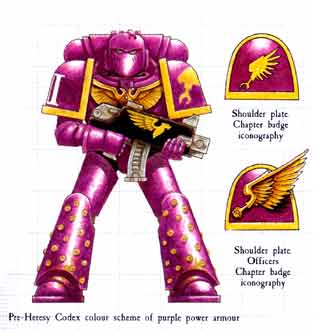 In
the centre of the crater, surrounded by the white-hoi remains of a stasis
capsule, was a child, barely more than a baby. Orphans were normally
put to death on Chemos - the Executive spared no resources to look after
those who were unable to return their investment by working in the factories
-but the captain of the Callax scouts looked into the eyes of the child
and saw something more than human. In defiance of tradition, the captain
of the scouts appealed to the Executive, Because of his value to Callax,
the captain was allowed to adopt the infant as his own. He named his
adopted son after an old legend long-since discarded by the people of
Chemos, the mythical god of creation Fulgrim. The child named after
this legend soon created a legend of his own, one that would become
known to all the people of his world.
In
the centre of the crater, surrounded by the white-hoi remains of a stasis
capsule, was a child, barely more than a baby. Orphans were normally
put to death on Chemos - the Executive spared no resources to look after
those who were unable to return their investment by working in the factories
-but the captain of the Callax scouts looked into the eyes of the child
and saw something more than human. In defiance of tradition, the captain
of the scouts appealed to the Executive, Because of his value to Callax,
the captain was allowed to adopt the infant as his own. He named his
adopted son after an old legend long-since discarded by the people of
Chemos, the mythical god of creation Fulgrim. The child named after
this legend soon created a legend of his own, one that would become
known to all the people of his world.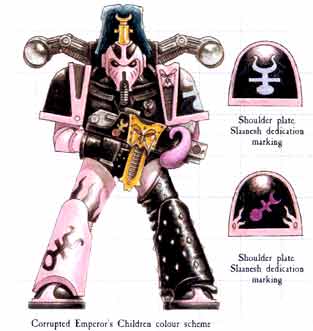 In
his spartan quarters, Fulgrim was faced by armoured warriors from the
stars. Their faces bore the scars of many battles, and from their shoulders
hung scrolls listing their achievements. Their armour and weapons were
finely-worked, and their banners and pennants were works of art. Fulgrim
recognised that these men were not merely advanced, but civilised -
his lost brothers from the stars had preserved the arts he had longed
to return to Chemos. From the midst of these warriors stepped their
leader, the Emperor of Humanity. Fulgrim surveyed him and, without a
word, knelt and offered his sword. On that day Fulgrim swore to serve
the Imperium with all his heart.
In
his spartan quarters, Fulgrim was faced by armoured warriors from the
stars. Their faces bore the scars of many battles, and from their shoulders
hung scrolls listing their achievements. Their armour and weapons were
finely-worked, and their banners and pennants were works of art. Fulgrim
recognised that these men were not merely advanced, but civilised -
his lost brothers from the stars had preserved the arts he had longed
to return to Chemos. From the midst of these warriors stepped their
leader, the Emperor of Humanity. Fulgrim surveyed him and, without a
word, knelt and offered his sword. On that day Fulgrim swore to serve
the Imperium with all his heart.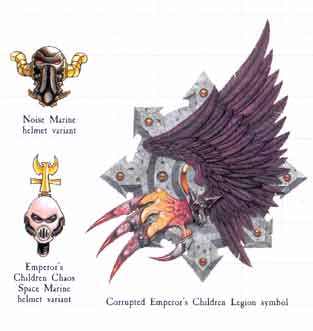 Swelled
by new recruits drawn from Chemos and Terra, the Emperor's Children
finally mustered the strength to undertake a crusade alone, and Fulgrim
proudly led his warriors into the unknown. To countless worlds he brought
the rule of the Emperor, crushing any resistance in the certain knowledge
that any who fought against the Emperor fought against Humanity itself.
From the growing ranks of his Legion, Fulgrim selected a few individuals,
the braves!, strongest and noblest, to become Lord Commanders, each
given charge of a full battle company. Fulgrim taught the Lord Commanders
personally, taking care that they were worthy of the honour of being
the representatives of the Emperor. In turn the Lord Commanders passed
Fulgrim's words on to the officers under their command, and they to
their squads. In this way, through their leaders, each Space Marine
of the Emperor's Children Legion followed the Emperor himself. To honour
the Emperor, they strove for perfection in all things: battlefield doctrine
was obeyed to the letter, tactics and strategy were studied in minute
detail and perfected, and the Emperor's decrees were memorised by every
Space Marine, adhered to in every way. While the Emperor's Children,
like many Legions, considered the Emperor a man, not a god, their reverence
and adoration for him bordered on the fanatical.
Swelled
by new recruits drawn from Chemos and Terra, the Emperor's Children
finally mustered the strength to undertake a crusade alone, and Fulgrim
proudly led his warriors into the unknown. To countless worlds he brought
the rule of the Emperor, crushing any resistance in the certain knowledge
that any who fought against the Emperor fought against Humanity itself.
From the growing ranks of his Legion, Fulgrim selected a few individuals,
the braves!, strongest and noblest, to become Lord Commanders, each
given charge of a full battle company. Fulgrim taught the Lord Commanders
personally, taking care that they were worthy of the honour of being
the representatives of the Emperor. In turn the Lord Commanders passed
Fulgrim's words on to the officers under their command, and they to
their squads. In this way, through their leaders, each Space Marine
of the Emperor's Children Legion followed the Emperor himself. To honour
the Emperor, they strove for perfection in all things: battlefield doctrine
was obeyed to the letter, tactics and strategy were studied in minute
detail and perfected, and the Emperor's decrees were memorised by every
Space Marine, adhered to in every way. While the Emperor's Children,
like many Legions, considered the Emperor a man, not a god, their reverence
and adoration for him bordered on the fanatical.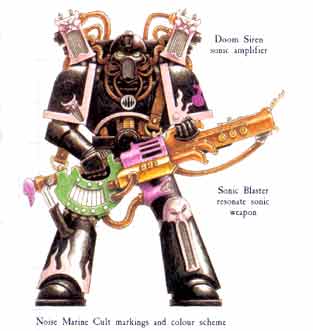 From
its humble beginnings, the Emperor's Children Legion continued to grow
until it met its eventual end in the Eye of Terror. By the time Fulgrim
joined the Warmaster in rebellion his Legion comprised 30 Companies,
each led by a Lord Commander, a charismatic individual who embodied
the best qualities of a Space Marine. As each Space Marine looked to
his superior officer for guidance, each Company inherited its manner
and practices from its Lord Commander. Though this was the case with
many Legions, the Emperor's Children had a strength of devotion to their
leaders that was almost unmatched.
From
its humble beginnings, the Emperor's Children Legion continued to grow
until it met its eventual end in the Eye of Terror. By the time Fulgrim
joined the Warmaster in rebellion his Legion comprised 30 Companies,
each led by a Lord Commander, a charismatic individual who embodied
the best qualities of a Space Marine. As each Space Marine looked to
his superior officer for guidance, each Company inherited its manner
and practices from its Lord Commander. Though this was the case with
many Legions, the Emperor's Children had a strength of devotion to their
leaders that was almost unmatched.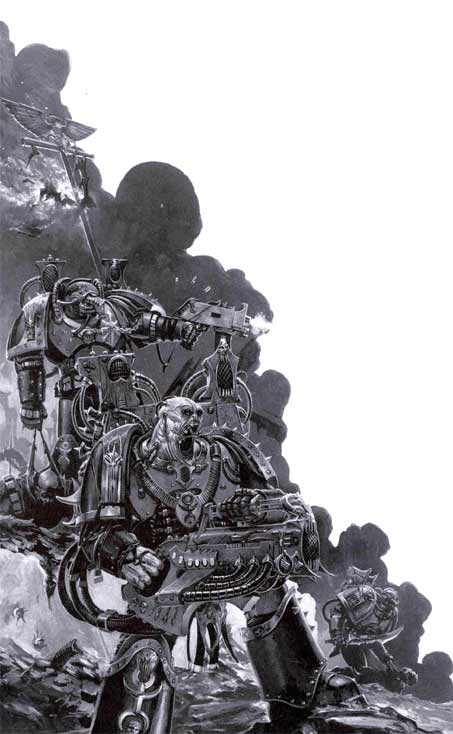 With
his Primarchs and Space Marines executing the Great Crusade, the Emperor
returned to Terra, intent on trengthening the Imperium which his forces
were building. Most knew that his place was at the heart of his Imperium,
but one man disagreed: Warmaster Horus, master of the now re-named Sons
of Horus Space Marine Legion, mightiest of the Primarchs. In his arrogance,
Horus believed the Emperor to be weak, a man unworthy of the battles
ought in his name. Upon hearing evidence of Horus's betrayal, the Emperor
sent seven entire Legions of Space Marines to challenge the Warmaster,
if necessary to destroy him. The Emperor's Children were the first to
arrive in the Istvaan system, where Horus waited, and Fulgrim met Horus
in person to demand he account for his actions. Instead, Horus succeeded
in corrupting his brother Primarch to the powers that now held sway
over him. The Council of Charon, formed after the Horus Heresy to discover
the causes of the traitor Primarch's betrayals, concluded that Fulgrim's
respect for Horus allowed the Warmaster to influence him, weakening
him enough for Chaos to lure him away from the Emperor. Slowly, as he
and Horus talked, Fulgrim's loyalty to Terra crumbled, replaced by a
burning desire to destroy the false Emperor, whose rule held back Humanity
from the perfection Fulgrim had always believed it capable of. Seduced
by Horus's words, Fulgrim turned to the promise of a new Humanity, a
Humanity that would rise to the peak of civilisation, a Humanity free
of the oppressive rule of the false Emperor. Slaanesh whispered to Fulgrim,
promising perfection in all things, and Fulgrim gave himself willingly
to his new god.
With
his Primarchs and Space Marines executing the Great Crusade, the Emperor
returned to Terra, intent on trengthening the Imperium which his forces
were building. Most knew that his place was at the heart of his Imperium,
but one man disagreed: Warmaster Horus, master of the now re-named Sons
of Horus Space Marine Legion, mightiest of the Primarchs. In his arrogance,
Horus believed the Emperor to be weak, a man unworthy of the battles
ought in his name. Upon hearing evidence of Horus's betrayal, the Emperor
sent seven entire Legions of Space Marines to challenge the Warmaster,
if necessary to destroy him. The Emperor's Children were the first to
arrive in the Istvaan system, where Horus waited, and Fulgrim met Horus
in person to demand he account for his actions. Instead, Horus succeeded
in corrupting his brother Primarch to the powers that now held sway
over him. The Council of Charon, formed after the Horus Heresy to discover
the causes of the traitor Primarch's betrayals, concluded that Fulgrim's
respect for Horus allowed the Warmaster to influence him, weakening
him enough for Chaos to lure him away from the Emperor. Slowly, as he
and Horus talked, Fulgrim's loyalty to Terra crumbled, replaced by a
burning desire to destroy the false Emperor, whose rule held back Humanity
from the perfection Fulgrim had always believed it capable of. Seduced
by Horus's words, Fulgrim turned to the promise of a new Humanity, a
Humanity that would rise to the peak of civilisation, a Humanity free
of the oppressive rule of the false Emperor. Slaanesh whispered to Fulgrim,
promising perfection in all things, and Fulgrim gave himself willingly
to his new god.